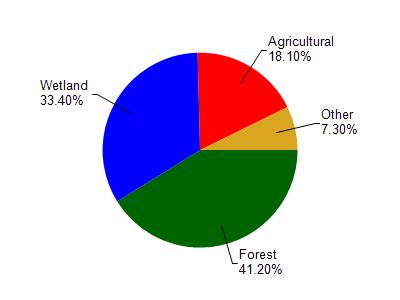Langlade
No
No
No
Fish and Aquatic Life
Overview
Airhole Lake is a very soft water seepage lake having slightly alkaline, clear water of low transparency. Lake bottom materials include muck (90%), with some sand, gravel, and boulders. The immediate shoreline is mostly upland (60%) of hardwoods and conifer and the remainder is wetland (40%) of coniferous bog. The lake was chemically treated in 1963 to remove the existing fish fry and has been restocked with largemouth bass, muskellunge, and golden shiner. Aquatic vegetation is sparse. Muskrat, as well asmigrating waterfowl, use this lake. Private shoreline development includes one resort and three dwellings. An unimproved public boat landing has been provided on the east shoreline. A total of 0.08 mile of the lake's 1.70 miles of shoreline is in public ownership. Source: 1977, Surface Water Resources of Langlade County Airhole Lake T-34-N, R-10-E, Sec. 33,
Surface Acres = 85.9, Maximum Depth = 10 feet, Secchi Disk = 2 feet
Date 1977
Author Aquatic Biologist
Condition
Wisconsin has over 84,000 miles of streams, 15,000 lakes and milllions of acres of wetlands. Assessing the condition of this vast amount of water is challenging. The state's water monitoring program uses a media-based, cross-program approach to analyze water condition. An updated monitoring strategy (2015-2020) is now available. Compliance with Clean Water Act fishable, swimmable standards are located in the Executive Summary of Water Condition in 2018. See also the 'monitoring and projects' tab.
Reports
Management Goals
Wisconsin's Water Quality Standards provide qualitative and quantitative goals for waters that are protective of Fishable, Swimmable conditions [Learn more]. Waters that do not meet water quality standards are considered impaired and restoration actions are planned and carried out until the water is once again fishable and swimmable
Management goals can include creation or implementation of a Total Maximum Daily Load analysis, a Nine Key Element Plan, or other restoration work, education and outreach and more. If specific recommendations exist for this water, they will be displayed below online.
Monitoring
Monitoring the condition of a river, stream, or lake includes gathering physical, chemical, biological, and habitat data. Comprehensive studies often gather all these parameters in great detail, while lighter assessment events will involve sampling physical, chemical and biological data such as macroinvertebrates. Aquatic macroinvertebrates and fish communities integrate watershed or catchment condition, providing great insight into overall ecosystem health. Chemical and habitat parameters tell researchers more about human induced problems including contaminated runoff, point source dischargers, or habitat issues that foster or limit the potential of aquatic communities to thrive in a given area. Wisconsin's Water Monitoring Strategy was recenty updated.
Grants and Management Projects
Monitoring Projects
| WBIC | Official Waterbody Name | Station ID | Station Name | Earliest Fieldwork Date | Latest Fieldwork Date | View Station | View Data |
|---|
| 967200 | Airhole Lake | 343045 | Airhole Lake - Deep Hole | 7/18/1979 | 7/18/1979 | Map | Data |
| 967200 | Airhole Lake | 10003339 | Airhole Lake | 7/27/1999 | 6/10/2017 | Map | Data |
|

Watershed Characteristics
Airhole Lake is located in the Upper Eau Claire River watershed which is 221.36 mi². Land use in the watershed is primarily forest (41.20%), wetland (33.40%) and a mix of agricultural (18.10%) and other uses (7.30%). This watershed has stream miles, lake acres and 40,234.77 wetland acres.
Nonpoint Source Characteristics
This watershed is ranked High for runoff impacts on streams, Low for runoff impacts on lakes and High for runoff impacts on groundwater and therefore has an overall rank of High. This value can be used in ranking the watershed or individual waterbodies for grant funding under state and county programs.However, all waters are affected by diffuse pollutant sources regardless of initial water quality. Applications for specific runoff projects under state or county grant programs may be pursued. For more information, go to surface water program grants.